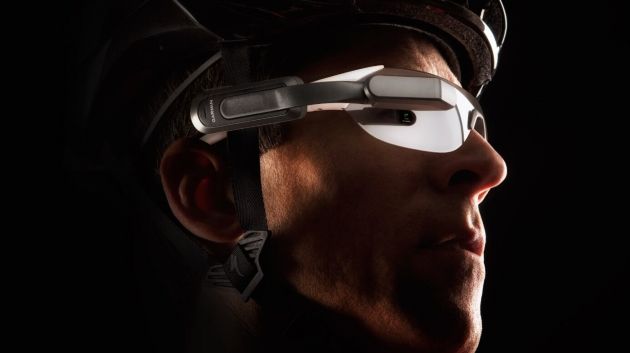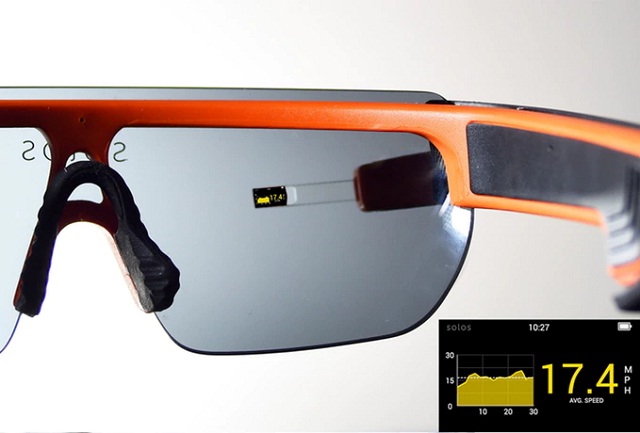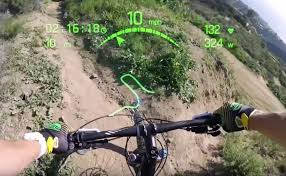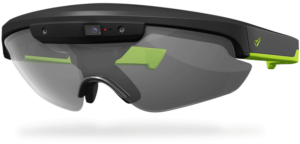Most technologies that are successful and widely adopted depend on a killer app’, something that is enabled by the technology and not enabled without it. AR has been looking for such a an application to help drive adoption. I think I know one.

I’m a keen cyclist (a physiotherapist said to me once ‘I thought you said that you were a keen cyclist. Aren’t they supposed to be skinny?’ I replied that I was a keen cyclist, but not a good one!). Anyway, as something of a geek as well, I love the information that modern technology can provide when I am on my bike. Now, there is no practical way to fit a HUD onto a bike, so a head-mounted display is the optimum solution.
Although I’m just a weak club cyclist, I still have a power meter so on my bike GPS, I can see my power output, heart rate, the direction I should be going, my cadence (pedalling speed), distance, time cycled, speed, climbing rate etc etc. However, with all this data, there is a temptation to spend too much time staring down at the GPS, taking attention away from the road – and that’s not a good idea. Especially it’s not a good idea if you are descending after a mountain climb. Even a cyclist of my skill can reach 40 mph/65kph (actually, that’s the speed I tend to apply some braking – the fast riders go much faster!) At that speed, you really need to focus on the road, not spend time looking at the screen. Lycra does not provide much crash protection.
So for several years, I have believed that cyclists were a natural early market for augmented reality glasses. The main reasons are:
-
Cyclists love the technology of their bikes and accessories. I have several friends that have spent $6000 to $8000 on their bikes. Then there is clothing and other equipment. A high end set of glasses/clothing/shoes/helmet plus a GPS and power meter could easily add another couple of thousand dollars or more. On top of that, there are costs in attending major events, buying trainer systems, feeding and hydration, coaching services and Strava subscriptions (a site that tracks your rides and allows competition with yourself and others).
-
Cyclists already spend a lot of money on glasses and sunglasses. My favourite online cycling retailer has ‘dumb’ glasses products up to $350 and say that their bestsellers cost $120.
-
The speed of cycling, especially in descents, means that switching focus from the road to a GPS display and back is potentially dangerous.
-
ANT+ and Bluetooth standards mean that it’s not that difficult to support speed sensors, cadence sensors, power sensors, heart rate monitors and other input devices.
So, I’ve been watching out for AR solutions that can provide the kind of real time data that I’m looking for in a glasses format. The two main contenders so far have been the Garmin Varia Vision display which costs £350 in the UK ($375 + tax) and gives 428 x 240 resolution for up to 8 hours and is designed to fit onto cycling glasses. The display is quite small and seemed expensive for what it was, to me. Battery life is quoted at 8 hours. Garmin is very successful in selling cycling GPS systems, but I have never seen anyone using the Varia Vision on a ride.
 Garmin’s Varia Vision
Garmin’s Varia Vision
The second product I have looked at over the years was the Kopin Solos cycling glasses, which have been developed in collaboration with the US national cycling team. These are complete sunglasses, including a display that is fitted to the front. The display in the Kopin glasses, like the Garmin, is a 428 x 240 resolution and both of these devices make the display quite adjustable in terms of where they are in the user’s vision, although both are separate physical displays, so they block some of the field of view around and behind the display area. The Kopin glasses are available online at $499 and battery life is quoted at 5+ hours.
 Kopin Solos imager
Kopin Solos imager
By chance, I went to register for the recent ‘Ride London’ event and was surprised to meet a new competitor in the field, Everysight, which has a new product, the Eyesight Raptor glasses, which are specifically designed for cyclists. The company is a spin-off from Elbit Systems and they use a central fixed display system that reflects the display image back off the inside of the glasses. That means that, in contrast to the Garmin and Kopin displays, the image is overlaid on the real world rather than blocking the view for part of the field of view. The image quality was quite impressive, although I only used it indoors, so it is hard to know how bright the image would look outdoors. They were quite comfortable and I thought that I preferred the AR system, as I have found that the Garmin and Kopin system need a bit of ‘tweaking’ to get a good view of the data.
The Everysight Raptor
The display is a WVGA+ OLED display with a display equivalent to a 65″ display at 12′ (3.7m) and the system is based on a Snapdragon 410E with 2GB of RAM and 16GB or 32GB of storage. There is a 13.2mp camera with 1080/P30 or 720/P60 video and there is a proximity sensor to detect when the glasses are being worn.
The glasses are effectively a complete system, based on Android, with weight of 98g (3.5 oz) and a claimed battery life of 8 hours, although staff told use that achieving that would mean pairing with a smartphone for GPS, rather than relying on the glasses for that function. The glasses have a number of different visors, with a light tint version available for use in darker conditions. The glasses can be controlled by side touch, voice or with a separate controller on the handlebars. The cost is £649 in the UK ($697 + tax) and the glasses have just gone on sale.

Cycling uber-geek, DC Rainmaker, reviewed the Raptor glasses after a brief ride and he was impressed with the outdoor display quality.
As for me, I decided to keep my cash in my pocket. Most years, I do at least one really long ride of up to 10 or 11 hours, so on the occasions when I would be most keen to use this kind of HMD, I would be in trouble with battery life and to even get close, I’d drain the battery on my smartphone by using the GPS there.
The vast majority of cyclists wear helmets, so it would be really good if there was some kind of standard for fitting batteries into helmets to allow the use of bigger ones, but with the weight distributed over the head, rather than just on the nose. BR

